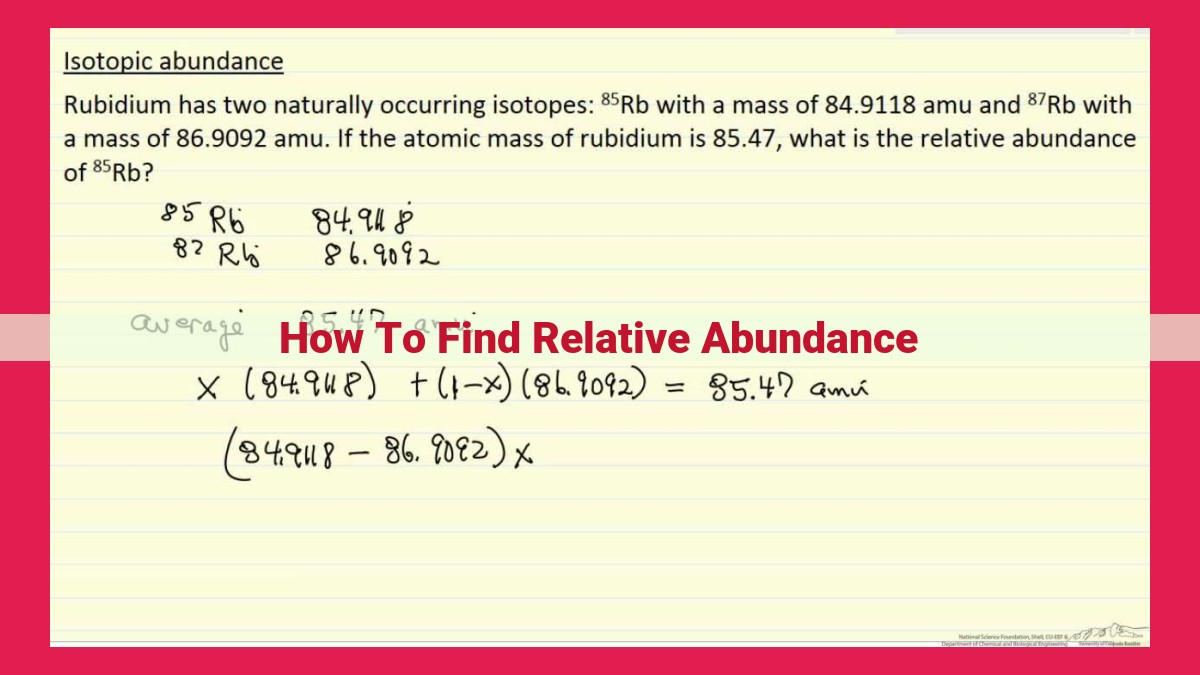Determining Relative Abundance For Ecological Insights: A Comprehensive Guide

To determine relative abundance, first understand its definition and ecological significance. Utilize sampling techniques to collect representative data on species richness, diversity, and evenness. Calculate relative abundance using diversity indices such as the Shannon index, which factors in both richness and evenness, or the Simpson index, which emphasizes dominance. Consider environmental, biological, and human influences that impact relative abundance. Applications include monitoring ecosystem health, assessing disturbance impacts, and guiding conservation efforts.
Understanding Relative Abundance: A Key to Unlocking Ecological Insights
In the intricate tapestry of nature, every species plays a unique role, contributing to the delicate balance of ecosystems. Relative abundance provides a crucial measure of the proportion of different species within a community, revealing patterns that shed light on the health and functioning of our planet’s ecosystems.
Definition and Importance
Relative abundance is the proportion of individuals of one species relative to the total number of individuals in a community. It provides valuable insights into the dominance and rarity of species, allowing ecologists to assess the structure and dynamics of ecosystems.
Related Concepts: Species Richness, Diversity, and Evenness
Relative abundance is closely intertwined with other key ecological concepts:
- Species richness: The number of different species in a community.
- Diversity: The measure of how many different species are present and how evenly they are represented.
- Evenness: The measure of how similar the abundance of different species is.
Understanding these concepts together provides a comprehensive picture of community composition and allows ecologists to make inferences about the health and stability of ecosystems.
Sampling Techniques for Studying Relative Abundance
When exploring the biological makeup of an ecosystem, understanding the relative abundance of different species is crucial. Sampling techniques play a vital role in obtaining representative samples that accurately reflect the population’s characteristics.
Distinguishing between Population and Sample
A population refers to the entire group of individuals sharing a common set of characteristics within a defined area. A sample is a subset of the population chosen to provide information about the larger group. It’s important to note that a sample should be representative of the population to accurately estimate the relative abundance of species.
Methods for Selecting Representative Samples
Random sampling is a method where each individual in the population has an equal chance of being selected. This ensures that the sample is unbiased and representative of the population.
Transects are linear paths established within the study area, along which individuals are observed or counted. Transect placement should consider the distribution and habitat preferences of the species being studied to ensure a more accurate representation.
Other sampling methods include quadrat sampling, where a fixed area is randomly selected and individuals within that area are counted, and mark-recapture methods, which involve capturing and marking individuals and then releasing them back into the population to estimate population size.
The choice of sampling technique depends on the study’s objectives, the species being studied, and the characteristics of the habitat. By carefully selecting representative samples, researchers can obtain accurate data on relative abundance, which is essential for understanding ecosystem dynamics and making informed conservation decisions.
Assessing Species Richness: A Key Measure of Ecological Health
In the tapestry of life, the diversity of species plays a crucial role in maintaining the balance and resilience of ecosystems. Among the key measures of biodiversity, species richness stands out as a fundamental indicator of ecological health.
Species richness refers to the total number of different species found in a particular area or habitat. It’s a critical metric because it reflects the variety of ecological roles and functions within the community. Rich communities are typically more resilient, as they can adapt to changing environmental conditions more effectively. Moreover, species richness provides insights into the health and stability of an ecosystem, as well as its potential for future ecosystem services.
Related Concepts:
Species richness is closely intertwined with other biodiversity metrics, such as diversity and evenness. Diversity measures the variety of species present, considering both richness and the relative abundance of each species. Evenness assesses the distribution of individuals among species, indicating whether certain species dominate the community or if there’s a more balanced distribution. Understanding these concepts collectively provides a comprehensive picture of community structure and ecological dynamics.
Measuring Species Diversity
Understanding the health of an ecosystem requires investigating not only the number of species present (species richness) but also how evenly they are distributed. This concept, known as species diversity, is crucial for assessing the stability and resilience of ecological communities.
Diversity indices provide a quantitative measure of the species distribution within a community. These indices consider both species richness and species evenness. Common diversity indices include the Shannon index and the Simpson index.
Shannon Index:
The Shannon index accounts for both richness and evenness, giving higher values to communities with greater species richness and more evenly distributed abundances. It is calculated using the natural logarithm of the proportion of individuals belonging to each species.
Simpson Index:
The Simpson index emphasizes the dominance of a few species within a community. It measures the probability that two randomly selected individuals from the same community belong to the same species. Higher Simpson index values indicate lower diversity, with a few dominant species.
These indices provide valuable insights into the structure and dynamics of ecological communities. They can be used to compare communities across different habitats, assess the impact of environmental changes, and monitor biodiversity trends over time. By understanding species diversity, ecologists can gain a better understanding of the overall health and resilience of ecosystems, guiding conservation efforts and environmental management strategies.
Calculating Relative Abundance Using Diversity Indices
When it comes to assessing the distribution and dominance of species within an ecosystem, relative abundance plays a crucial role. Researchers delve into this concept by employing diversity indices, mathematical tools that quantify the richness and diversity of a community.
One widely used index is the Shannon index, which incorporates both species richness and evenness. It provides a more comprehensive measure of diversity by considering not only the number of species but also their relative proportions. The formula for the Shannon index is:
H' = -∑(p_i * ln(p_i))
where p_i represents the proportion of individuals belonging to the _i_th species.
Another commonly employed index is the Simpson index, which emphasizes dominance. It assigns greater weight to species with larger populations, making it particularly useful for identifying dominant species. The formula for the Simpson index is:
D = ∑(p_i^2)
By applying these indices, ecologists can calculate the relative abundance of species within a community. This information is essential for understanding the ecological dynamics within an ecosystem, monitoring changes over time, and assessing the impact of environmental disturbances on species distribution.
Factors Shaping Relative Abundance: A Tale of Nature, Biology, and Human Impact
Environmental Factors: Nature’s Guiding Hand
The environment plays a pivotal role in determining species’ relative abundance. Habitat characteristics, such as food availability, shelter accessibility, and temperature ranges, influence which species can thrive in a given ecosystem. Resource availability, in particular, can greatly impact species’ numbers. For instance, areas with abundant food sources often support a higher density of herbivores, while carnivore populations may flourish in regions where prey is plentiful.
Biological Factors: The Dance of Life
Biological factors also exert a profound influence on relative abundance. Life history traits, such as reproduction rates and longevity, affect how quickly populations can grow and recover from disturbances. Species with rapid reproduction and short generation times tend to recover more easily from setbacks, while those with slower life cycles may struggle to regain their populations. Additionally, dispersal abilities determine how far individuals can spread and colonize new areas, which can impact their relative abundance across different habitats.
Human Activities: A Double-Edged Sword
Human activities can dramatically alter the relative abundance of species. Habitat modification, such as deforestation and urbanization, can destroy or fragment natural habitats, reducing the availability of resources and shelter for native species. Introduced species, whether intentional or accidental, can disrupt ecosystem dynamics and outcompete native species for resources, leading to population declines. Conversely, conservation efforts and habitat restoration can help to protect and increase the abundance of threatened or endangered species.
Understanding these factors is crucial for effectively managing and protecting ecosystems. By considering the complex interplay of environmental, biological, and human influences, we can gain insights into species’ distributions, vulnerabilities, and the measures necessary to ensure their long-term survival.
Applications of Relative Abundance
Understanding the relative abundance of species within an ecosystem is crucial for assessing its health and biodiversity. By analyzing the relative dominance of different species, ecologists can gain valuable insights into the stability and resilience of the ecosystem.
One key application of relative abundance is monitoring ecosystem health and biodiversity changes. By tracking the relative abundance of species over time, ecologists can detect shifts in the community composition. These shifts may indicate changes in environmental conditions, the presence of invasive species, or the impact of human activities. For instance, if a once-dominant species shows a decline in abundance, it could signal a change in habitat quality or increased competition from introduced species.
Relative abundance also plays a crucial role in assessing the impact of environmental disturbances. Natural events such as fires, hurricanes, and droughts can significantly alter the relative abundance of species. By studying these changes, ecologists can understand the vulnerability of different species and identify those that are most susceptible to environmental stressors. Moreover, it helps researchers evaluate the effectiveness of conservation measures and restoration efforts by comparing the relative abundance of species before and after interventions.
Finally, relative abundance guides conservation priorities and management strategies. By identifying species that are rare or have declining populations, ecologists can focus their efforts on prioritizing these species for conservation. Understanding the relative abundance of species can also inform the design of management plans that aim to maintain biodiversity and ecosystem stability. For example, if a keystone species is found to be underrepresented, conservation efforts may be directed toward enhancing its habitat or reducing threats to its population.
By leveraging the knowledge of relative abundance, ecologists can gain a deeper understanding of ecosystem dynamics and the factors that shape species distributions. This information is essential for developing effective conservation and management strategies to protect biodiversity and ensure the long-term health of our ecosystems.




